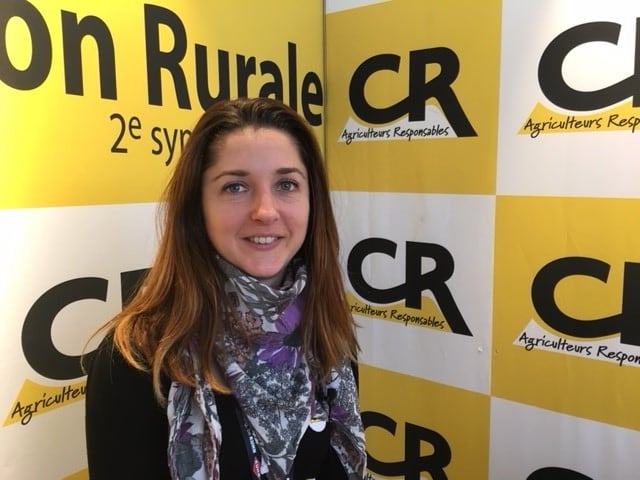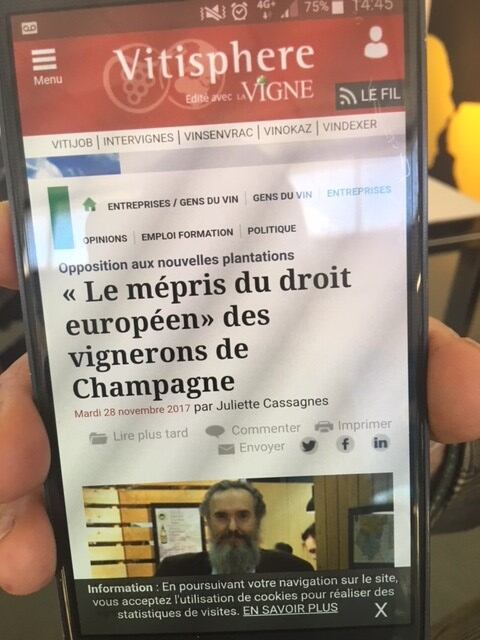BeverageDaily spoke to Bersac at the SITEVI tradeshow (November 28-30) in Montpellier, France, at the Coordination Rurale, French trade union stand, as well as VCR (Vivai Cooperativi Rauscedo), a cooperative nursery, based in NorthEastern Italy, which promotes disease-resistant vines.
Coordination Rurale

Bersac and VCR has worked in partnership with SyVIF and SyVINO, which represents six departments in France; the Ardennes, Aisne, Oise, Seine-et-Marne, Haute -Marne and the Meuse.
The Champagne-Ardenne region consists of four departments - the Ardennes (08), the Aube (10), the Marne (51) and the Haute-Marne (52).
Bersac wants to plant vines in three departments on the outskirts of the champagne region: Aisne, Seine-et-Marne and Ardennes. He also wants to help other winegrowers in three other departments on the east side of the champagne area who have the same problem.
SITEVI is the international exhibition of equipment and expertise for vines, olives, fruit and vegetables.
Bersac used the event to announce he has contacted Maxime Toubart, president, SGV, ahead of his meeting with the Minister of Agriculture, Stéphane Travert on December 4, to ask him to rethink a decision banning a project to have vineyard plantations with no GI (Geographic Indication) or European IGP (Indication Géographique Protégée) near the Champagne Appellation d'Origine Controlée (AOC) area, between 2018-2019.
The SGV opposed a similar project for planting vineyards without GI or IGP, in its wine region, covering Aisne and Seine-et-Marne in 2016.
“To ban this project defies European law,” said Bersac.
"We must stop this decision from going ahead and appeal to the Minister of Agriculture himself. I have personally written a letter to the minister presenting my arguments and asking for an appointment.
“The objective is to find a way out of the conflict and avoid a litigation process. The board of directors of the CR union is ready to appeal to the Council of State in case an order is made in the favor of the SGV.”
EU deregulation of vineyard planting rights

The deregulation of vineyard planting rights across the European Union came into effect on January 1, 2016.
The previous system of planting rights was scrapped in favour of individual, ‘non-transferable authorisations’ that can be granted even on land that was previously not considered suitable for vines.
Under the new rules, French regions such as Picardie or the Ile de France around Paris can legally bottle and sell wine commercially, whereas previously any wine produced in these zones could only be for personal consumption.
Under the new rules, the three levels for labelling wine are AOC/AOP (appellation controllée), IGP (indication géographique protégée) and VSIG (vins sans indication géographique, replacing the former table wine category).
Winemakers in all three levels can apply for planting authorisations.
The Champagne region
About 85%-90% of Champagnes are a blend of about 2/3 red grapes and 1/3 Chardonnay. A few Champagnes (less than 5%) are 100% Chardonnay (they are called blanc de blancs); fewer yet are 100% red grapes (called blanc de noirs). Rosé Champagnes, a small category, are usually, but not always, made from a blend of white and red grapes.
A few minor grapes — such as Petit Meslier, Arbanne, and Pinot Blanc — still survive in some of the region’s vineyards and are still permitted, but they cannot be replanted and are of little consequence.
BeverageDaily has contacted SGV for comment.
